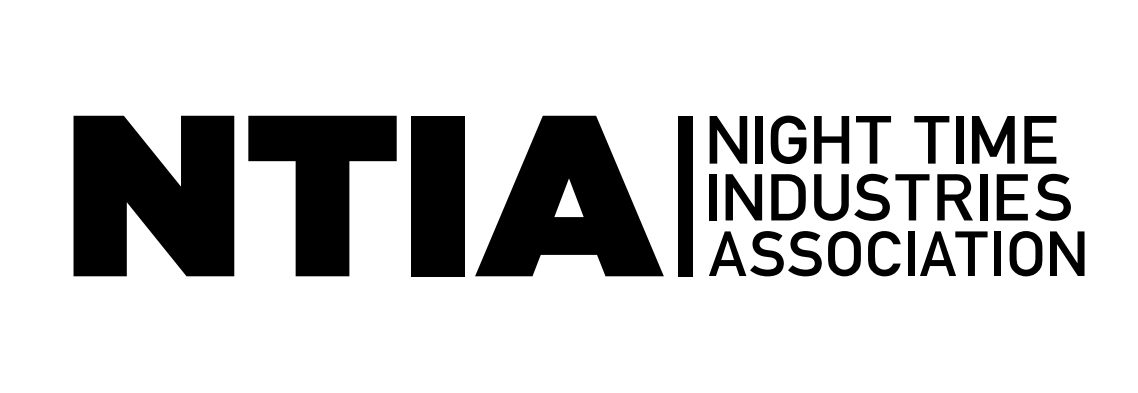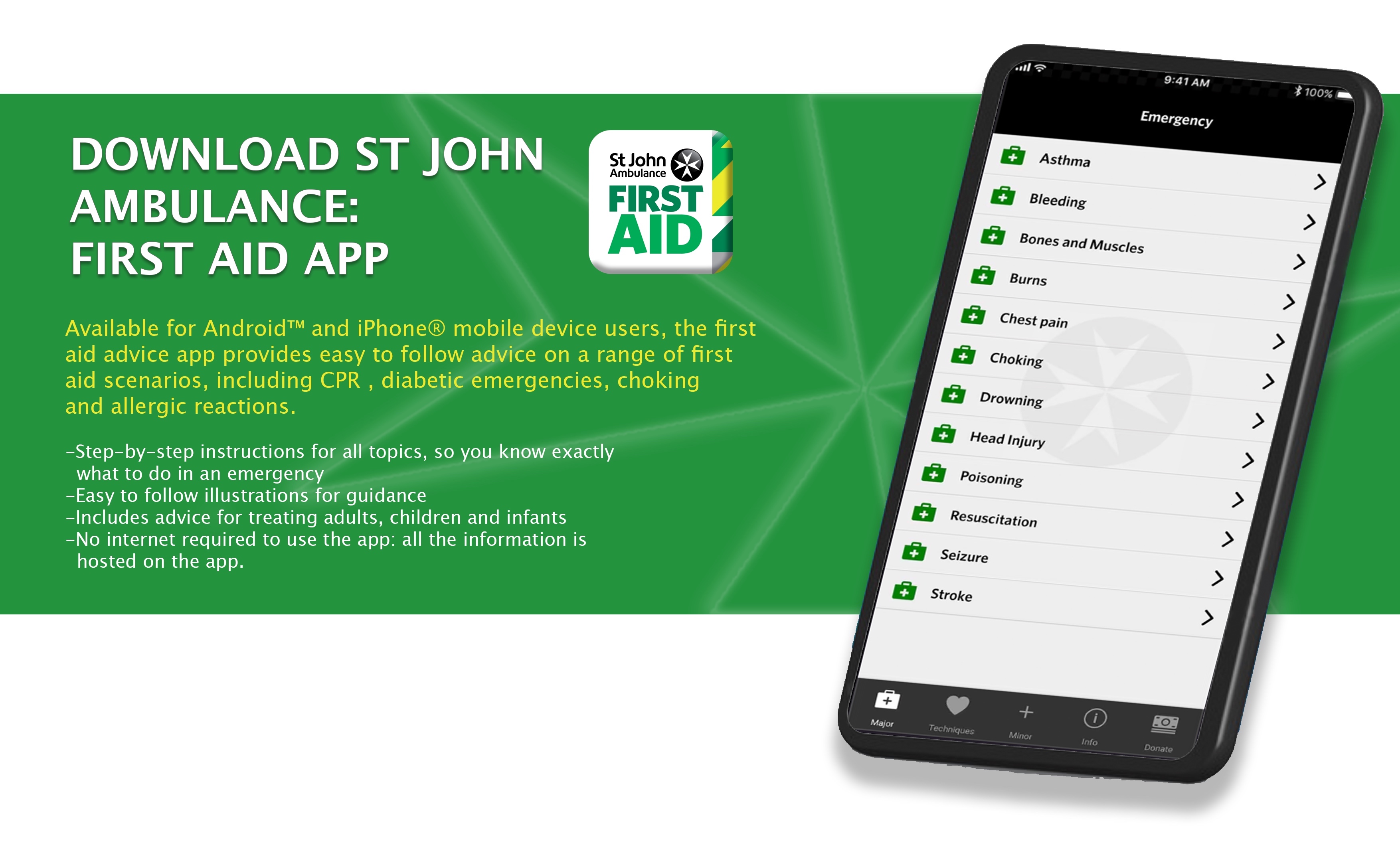Contacts
Head Office Tel: 0844 282 4300 │ Email: office@leisuresec.co.uk
Control Room Tel: 0345 218 4300 │ Mobile: 07426 393239 │ Email: controlroom@leisuresec.co.uk
REGIONAL MANAGERS
Mark Watkins (National) Mobile: 07815 147042 │ Email: mark.watkins@leisuresec.co.uk
Peter Green (South) Mobile: 07831 585814 │ Email: peter@clearwaterpeople.com
Suraj Kang (North) Mobile: 07943 669083 │ Email: suraj_kang97@hotmail.co.uk
IMPORTANT INFORMATION:
Vetting to office@leisuresec.co.uk
Time sheets must be sent to wages@leisuresec.co.uk by Tuesday 12:00.
Client premises inductions:
www.leisuresec.org/security-operative/client-premises-induction
Shift Cover Procedure
If you or a door supervisor cannot/has not attended a shift, please following the below procedure.
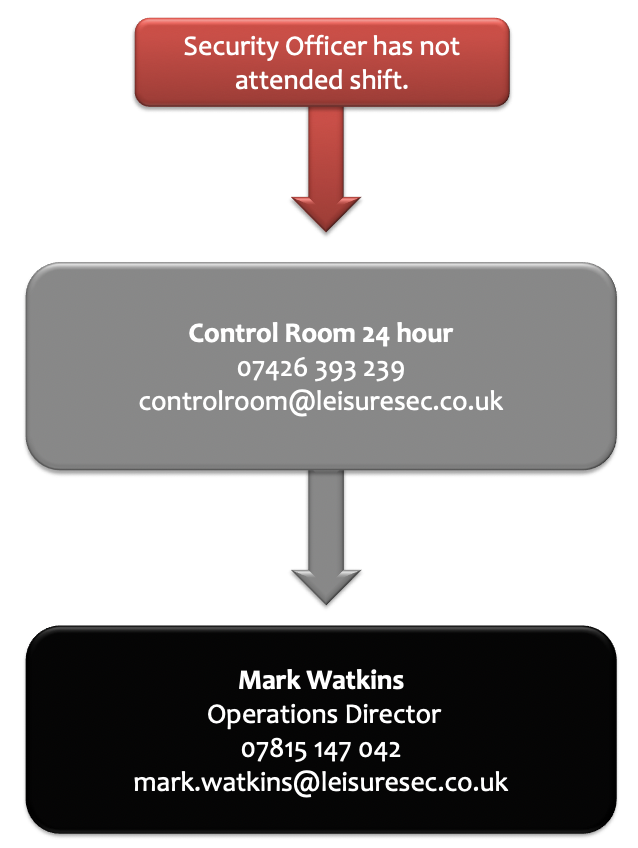
Code of Conduct for SIA Licence Holders and Applicants
Act with honesty and integrity Be trustworthy Protect the people and property you are entrusted to protectBe professional at work Act with fairness and impartiality at work Be accountable for your decisions and actionsLeisuresec Mission Statement
The Directors, Managers and Stakeholders within Leisuresec promise that we will:
- Create and maintain a secure and safe environment for our clients and their assets.
- Continually review how we deliver our service in order to operate at optimum levels.
- Operate fairly, profitably and ethically in all our dealings with customers, suppliers, and work force.
- Listen to our clients needs and respond to every request within 24 hours.
- Minimise our carbon footprint by using the very best local resources wherever possible
- Motivate our workforce to excel in their duties.
- Train nurture and inspire our work force to exceed client expectations.
- Operate transparently to show clients how we achieve our results.
- Apply tried and tested systems to objectively audit our service delivery and where improved systems are available we will incorporate them into our processes.
- Continually research and embrace new technology to improve communication and service delivery.
- Provide our customers with one phone call access to decision makers and to deliver results.
- Treat the trust our customers have placed in us with the respect it deserves and deliver a service to be proud of.

| JOB TITLE: | Door Supervisor |
|---|---|
| RESPONSIBLE TO: | Head Door Supervisor/ Duty Manager |
| SUBORDINATES OF: | Area Manager |
| RESPONSIBLE FOR: | Assisting management in the provision of a safe and secure environment for visitors and employees, portraying the company image and ethos at all times |
| BEFORE COMMENCING DUTIES: | Complete the Induction Training process using the Assignment Information. |
Risk Assessment
This Risk Assessment is a general evaluation of the hazards that could occur at a venue. Some of the areas included will not be relevant to all venues, for example, monitoring cloak rooms, car parks or lone working.
Venue specific details should be included when you complete your induction. Venues will also have their own policies and procedures in place for Health & Safety, Emergencies, etc.
| DUTY | SIGNIFICANT HAZARDS | CONTROL MEASURES |
|---|---|---|
| Managing front of house. |
|
Queueing systems should be evaluated in case of congestion, e.g. not blocking fire escapes, adhere to noise regulations of the surrounding area. Greet all customers may help to build rapport and evaluate their condition. Rejections and ejections should be reported in the Daily Occurrence Log |
| Managing the Reception Area | Use your training to organise a queuing system and monitoring it. | |
| Searching toilets | Communicate with management/ supervisor before conducting check. Radio on completion of toilet | |
| Ejecting customers from the venue |
All security operatives will have completed the SIA Physical Intervention course Never eject anyone by yourself, always call for assistance |
|
| Managing Bar Area | Use your training to maintain order of the queuing system. | |
| Managing Other Leisure Areas (e.g. Gaming Area, Dance Floor, restaurant etc | Use your training to observe and identify potential incidents and accidents to prevent escalation. | |
| Managing Cloak Room | Use your training to organise a queuing system and monitoring it. | |
| Searches |
Communicate with management/ supervisor before conducting a search. Use your training, we have provided guidance for searches in this manual. |
|
| Patrolling halls corridors and stairwells | Use your training to observe and identify potential incidents and accidents to prevent escalation. | |
| Monitoring Car Park |
|
Remain vigilant at all times when moving in the vicinity of vehicles. All persons to use footpaths and designated walkways. Wear PPE including hi viz. |
| Lone Working | Staff could suffer injury or ill health due to physical assault, accidents or personal medical conditions | Undertake hourly welfare check calls. Emergency procedures in place to respond to lack of regular contact with lone workers. DS trained in conflict management as part of their SIA licencing training. |
Additional Risk Control Information:
- CCTV is in operation at most venues and covers the main areas, however, some areas might not be covered
- Most Leisuresec venues have a direct contact to police camera control
- All venues can be supplied with Body Cameras but to adhere to strict GDPR procedures
- All venues have access to Radios
SIA Standards of Behaviour for Door Supervisors
Published By: Night Time Industry Association
What are the SIA Standards of Behaviour for door supervisors?
The Security Industry Authority (SIA) is the body responsible for licensing individuals working within the Private Security Industry, including door supervisors. The SIA has set out standards of behaviour that they expect door supervisors to follow. The aim of the Standards of Behaviour is to set, raise and maintain national standards of behaviour for door supervisors and set out the rules that door supervisors should always follow.
The authority of door supervisors to carry out their duties comes from the premises licence holder, or the premises management acting on behalf of the premises licence holder, and they can ask door supervisors to follow additional rules. However these additional rules should never conflict with the SIA standards.
What do the SIA Standards of Behaviour cover?
The Standards of Behaviour cover the following main areas:
Personal appearance
Door supervisors should always:
- wear smart, presentable clothes that show clearly that they are a door supervisor. Clothing must also meet employer guidelines
- wear their SIA licence on the outside of their clothing, with the photograph displayed, at all times while on duty.
Professional attitude and skills
Door supervisors should always:
- treat people in the same way as they would like to be treated
- greet visitors in a friendly and polite manner
- act fairly and not discriminate on the grounds of gender, sexual orientation, ethnicity, disability, marital status or any other difference in individuals which is not relevant to the door supervisors’ responsibility
- carry out their duties in a professional and courteous manner with due regard and consideration to others
- behave with personal integrity and understanding
- use moderate language, which is not defamatory or abusive, when dealing with members of the public and colleagues
- be fit for work and remain alert at all times
- develop appropriate knowledge of local services and amenities.
General conduct
Door supervisors should:
- never solicit or accept any bribe or other consideration from any person
- not drink alcohol or be under the influence of alcohol or drugs whilst on duty
- not display preferential treatment towards individuals
- never abuse their position of authority
- never carry any item which is or could be considered threatening
- report all incidents to the management
- co-operate fully with members of the police, local authority, SIA and other statutory agencies such as Trading Standards and HM Revenue and Customs, who have an interest in licensed premises and the way they are run.
What are the main roles and objectives of door supervisors?
As a door supervisor you may work at a variety of licensed premises such as pubs, nightclubs, casinos or maybe even big outdoor festivals such as Glastonbury or Reading. Whatever the venue type, your main objectives are to ensure that customers have an enjoyable experience in a safe environment and to support the licensing objectives.
To meet these objectives, door supervisors have a number of roles that they must carry out as part of their duties. These include:
Delivering customer care by creating a safe and secure environment
To do this you need to have a professional and effective manner when:
- meeting and greeting your customers
- helping your customers
- dealing with customer concerns
- controlling the door
- controlling behaviour inside the premises.
Controlling entry to the premises
Door supervisors are responsible not only for who enters the premises, but also what enters the premises, such as drugs, weapons etc. When dealing with people, door supervisors are responsible for refusing entry to those who:
- are drunk or are under the influence of drugs
- do not follow the dress code
- have a reputation for criminal or bad behaviour
- exhibit aggressive behaviour
- refuse to be searched when requested by a door supervisor
Door supervisors are also responsible for controlling the number of people entering premises. Every licensed premises will have a permitted capacity limit i.e. the maximum number of people who can be on the premises at any one time. This limit will be set by the
premises licence holder and the relevant authorities, and will depend on factors such as the size of the premises, the number of fire exits etc. Once the number of people on the premises has reached this limit, it is the door supervisors’ job to not let any more customers in until some customers leave.
Monitoring behaviour inside the premises
Once inside the premises, most customers behave well and just want to have a good time. However, there are always the exceptions, and it is the job of the door supervisor to watch what is going on inside the premises and deal quickly with those who:
- threaten the safety of other customers
- spoil the enjoyment of other customers
- put the management’s premises licence at risk.
Enforcing the law and helping to prevent criminal offences
When working as a door supervisor part of your role will be to:
- explain to customers who breach house rules that their behaviour is unacceptable
- handle complaints and disputes over service (e.g. between customers and bar staff)
- defuse domestic disputes between customers
- handle other arguments and fights
- encourage customers to finish drinks and leave the premises at closing time.
Refusing entry, searching, evicting and arresting
To make sure that the majority of your customers enjoy their time at your premises and to help the premises licence holder to work towards the licensing objectives of the Licensing Act 2003, you may need to:
- politely refuse entry
- search people for drugs, weapons and other prohibited items
- evict people – for example, for fighting, being drunk and disorderly or for other unacceptable behaviour
- possibly arrest people.
Other duties
Door supervisors do a great deal more than just look after the door and you may be asked to do any or all of the following as part of your role:
- pre-entry safety checks
- emergency and evacuation procedures
- first aid
- health and safety
- assisting in the normal operation ofthe premises.
Use your own skill judgement and experience in providing these services in compliance with the guidelines and ethos of the Security Industry Authority.
View the full guidance provided by the NTIA here.
Uniform
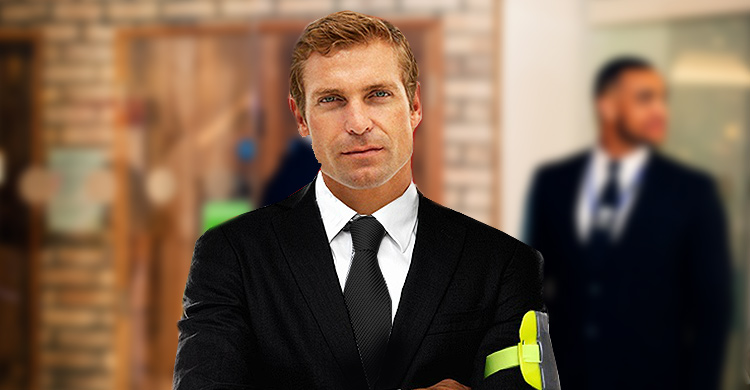
Standard Industry Requirements:
Black SuitWhite ShirtsBlack TrousersBlack TiesBlack Shoes
Whilst on duty, unless otherwise instructed by management, it is a legal requirement for security operatives to display their SIA licence at all times, usually by wearing a high-visibility arm band.
Before your shift...
- Before the start of your first shift you will given a tour of the premises and the procedures as an induction. You can complete your induction here.
- A risk assessment has been completed for the premises and consulting it before commencing a task will ensure you are aware of any changes to the role and the associated risks.
- There will be a signing-in book to log each of your shifts. Please record precise information as erroneous entries may delay payment of your fees.
Challenge 25
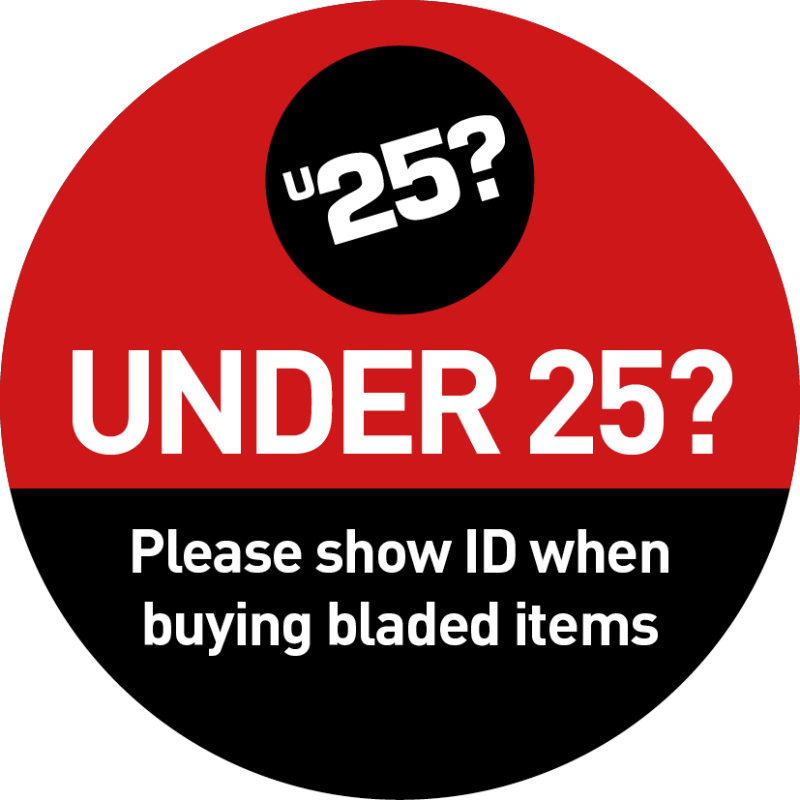
The Licensing Act 2003 introduced mandatory conditions on every alcohol licence, including one that requires all premises to have a policy in place in order to prevent underage sales.
Access Control and Searching
Published By: Night Time Industry Association
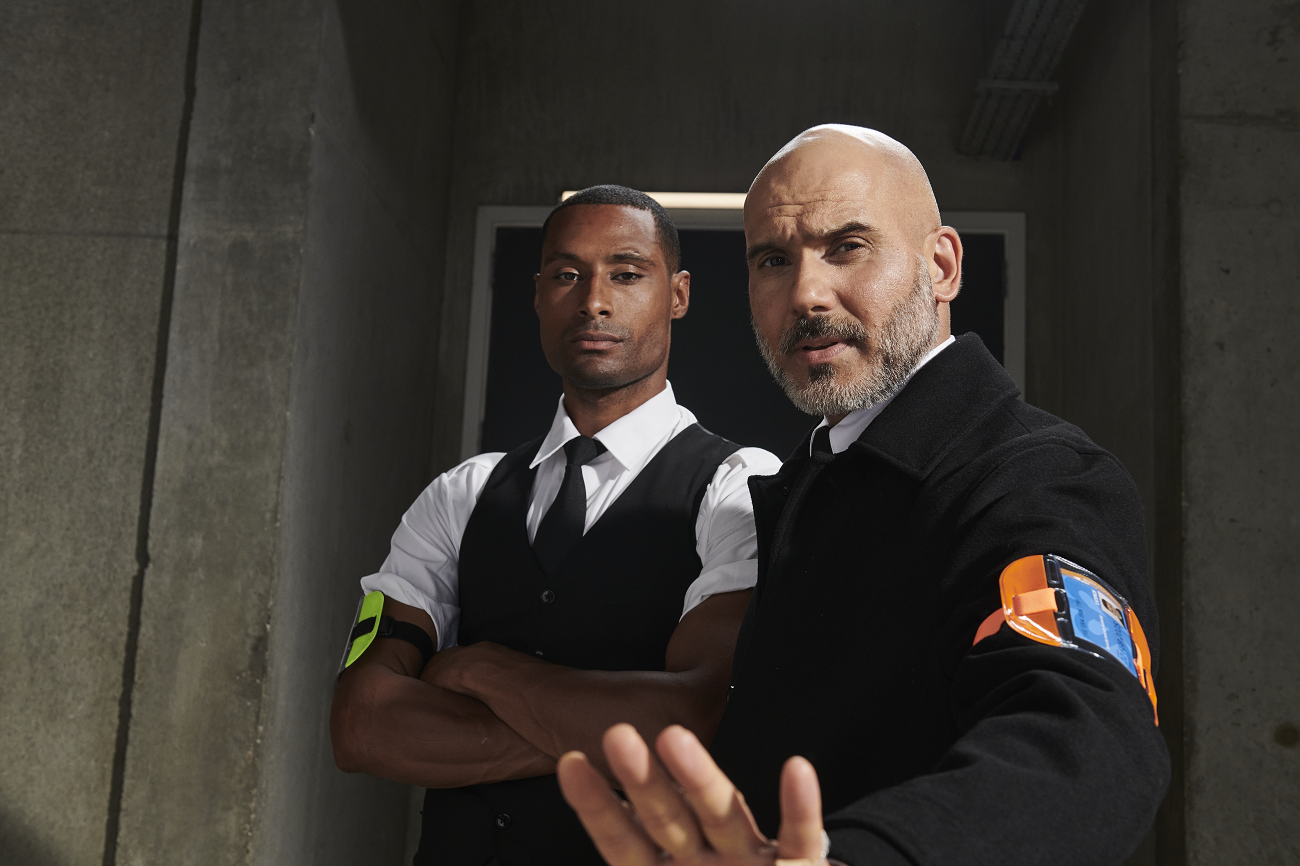
Why is an admissions policy important?
It is important for licensed premises to have an admissions policy as it helps to ensure that a consistent approach is taken on the door. This means that customers know what to expect and door supervisors can pre-warn customers in the queue if they know that they will not be allowing a certain person or group into the premises. The benefit of this is that conflict is less likely to escalate if people are not kept waiting in a queue only to be told that they are not allowed in.
There are two main reasons for having an admissions policy.
- The law – there is a legal requirement not to let anyone enter or remain on licensed premises who is:
- underage
- drunk
- disorderly
- a suspected or known drug dealer.
- The permitted capacity limit – The conditions of the premises licence will almost always state the maximum number of people allowed in the premises at any one time. Staff are not always included in this figure because there must be enough trained staff on the premises to help in emergency situations. See Chapter 8 for more on permitted capacity limits.
Many licensed premises will also add other conditions to the admissions policy, for example details of a dress code and the premises’ search policy. It is important for such information to be on display so that customers know, for example, that trainers are not permitted on a Saturday night, or that premises have a policy to search customers. This way, customers know what to expect and are less likely to react badly if they are not permitted entry or are asked to empty their bags and pockets. Although these, and any other additional elements of an admissions policy, are important to each individual premises, they are not the main or most important reasons for having an admissions policy.
As well as welcoming customers, a door supervisor is responsible for following the admissions policy of the premises, firstly to ensure safety in the premises and secondly to make sure that house rules and standards are followed. To make this easier and to avoid conflict arising as a result of customers being refused entry the door supervisor must:
- meet and greet all customers in a polite and friendly way
- safely control the entry of customers and monitor the queue
- carry out searches
- deny access to any undesirable persons (e.g. those who are drunk, disorderly, under the influence of drugs or underage).
Authorised persons
Remember the police have a legal right to enter licensed premises at any time if they suspect that an offence against licensing law is being committed or is about to be committed. It is an offence to obstruct the police and other officials. Other officials such as local authority licensing officers, Environmental Health officers, HM Revenue and Customs officers or fire authority officers also have a legal right to enter the premises.
Refusing entry
You might have to refuse entry for many important reasons depending on the premises’ policy, and in order to uphold licensing law.
Entry might be refused because:
- the premises is full
- a person is under the influence of alcohol or drugs
- a person is underage
- a person refuses to be searched
- a person is a known troublemaker, has already been barred or is under an Exclusion Order issued by the courts
- a person’s attitude would spoil other people’s enjoyment
- a person does not comply with the dress code
- a person cannot or will not pay the entrance fee
- a person is found in possession of weapons or drugs.
You must stop persons who are drunk, violent, quarrelsome or disorderly from entering the premises. You may also have to escort or remove such persons from the premises after admission. Police are considered to be experts in determining who is drunk.
REMEMBER – it is against the law to refuse entry only on the grounds of race, gender, sexuality, physical appearance or disability.
Do not confuse a person who is drunk with someone who has a disability, for example, a person who has:
- speech difficulties and who also may be deaf
- cerebral palsy, who may move limbs suddenly
- learning disabilities.
When you refuse entry to someone, you must always:
- be polite
- fully explain your reason for refusing entry.
Refusing does not mean rejecting
When you have to refuse entry to a person because a premises is full, for example, explain to them why you are unable to admit them. When you have to refuse entry to a person because they are drunk, explain to them that you are unable to admit them because on this occasion they have had too much to drink. Remember, you are not personally rejecting that person, but their condition.
What to do when someone will not accept refused entry
People may not accept the reason for being refused entry. Your premises may have a policy about what to do in such cases. You should find out what this is, but the general rules to follow are:
- when someone will not accept the refusal you should call the manager or designated premises supervisor
- if, after the management’s intervention, the person still will not accept the refusal you should call the police.
The police have a legal duty to assist with an eviction if they are called because the person is either drunk or disorderly. If a person has been refused entry and enters the premises anyway, they commit the civil offence of trespass. Again, you may need to call the police if the person refuses to leave.
REMEMBER – a door supervisor has no power to arrest someone for trespassing.
Controlled exit and dispersal
Where appropriate, premises licence holders should have dispersal policies, which have been produced in consultation with the police and local licensing officers. These policies will show the steps the premises will take at the end of the trading session to minimise the potential for crime and disturbance as customers leave the premises. The policy may include:
- displaying details of local taxi services, mini-cabs and public transport
- regular collection of empty glasses and bottles, particularly just after closing. There may also be signs saying that leaving with glasses and bottles is not allowed
- displaying notices near the exit requesting customers to leave quietly.
The role of door supervisors in controlled exit and dispersal
Door supervisors can play a key role in several aspects of any dispersal policy by:
- encouraging customers to drink-up and make their way to the exit
- drawing the attention of departing customers to any notices in the foyer asking them to leave quietly and to be considerate ensuring that bottles and glasses are taken from customers as they leave
- actively encouraging customers not to congregate outside the premises
- directing customers to the nearest taxi ranks, or other transportation away from the area.
Searching
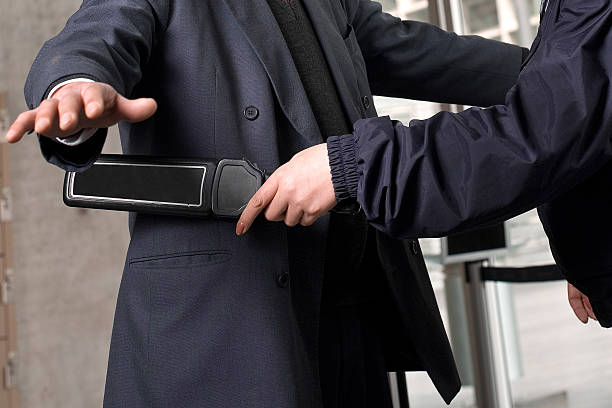
Searching premises – pre-entry premises checks
Before customers are allowed in, it is the responsibility of the designated premises supervisor or manager to check that all reasonable measures have been taken to make sure the premises are safe. This check may be part of your job as a door supervisor and there may be a checklist to help you carry this out. Members of the public should never be admitted until all pre-entry checks have been done and any problems have been resolved. The following checks must be carried out every time the premises are to open for business:
- Exit routes – All emergency exit routes must be free of obstructions so that customers can leave the premises quickly and easily. This cannot take place if emergency exit doors are locked or if exit routes are blocked. Emergency exit doors usually open in the direction of the escape and can therefore be kept closed. They must be left unlocked. Inward opening doors should be kept open so that they can be used easily in an emergency.
A pre-entry check must ensure that:
- all exit doors are unlocked and can be used
- any chains, padlocks or other fastenings have been completely removed
- panic bolts and latches should be checked to ensure they can be opened easily
- there are no obstructions, such as parked cars outside the doors or rubbish inside or outside exit doors
- escape routes are not reduced by furniture or rubbish
- any fire hazard, such as waste paper or litter, is removed
- all fire exits signs are lit and clearly visable, for example, not obstructed by curtains or posters.
- Fire doors must be kept closed as the purpose of a fire door is to make sure that fire is contained behind the door while customers and staff escape. Fire doors stop smoke and flames from spreading into escape routes and other parts of the building. Most fire doors are self-closing, but if a fire door has to be kept open during operations, devices can be used to close it if there is a fire. In every case where there is such a device, the local authority must agree to it. If you are responsible for checking fire doors in your premises, you must find out from the manager whether any open door has this local authority permission.
- Fire-fighting equipment, such as fire extinguishers and hose reels, must be in the positions stated by the fire authority and must be ready to use. They must be placed on their brackets. They should never be used to prop open doors. Unless you are a trained fire-fighter, you should not try to tackle even small fires.
- Emergency lighting – Emergency exits must be well lit and checks should be made to ensure that exit routes, stairways and fire signs are properly lit. Exit signs must always be clearly visible.
- In most premises there is an emergency battery-operated lighting system. This will automatically activate if the mains lighting fails. This system must be checked to make sure it is in working order before the premises open.
- Public address/fire alarm systems – All public address systems and/or fire alarms must be checked and in working order. The legal requirement is a test every 7 days.
REMEMBER – Make sure that you know what your responsibilities are for all pre-entry checks.
Searching people
Why carry out searches?
Searching customers ensures safety. Customer and bag searches are carried out to ensure that no weapons, drugs or other items are brought in which could:
- spoil other customers’ enjoyment
- put staff and other customers in danger
- make the management liable to prosecution.
You may need to search potential customers before you allow them into your premises. You may also have to search customers after they have been admitted to the premises. You therefore need to know your premises’ procedure for searching people before and after admission.
Types of search
There are three main types of search:
- a general search, when you will be required to search all customers
- a random search, when customers to be searched are selected at random so, for example, 1 in every 10 customers may be searched (selection is usually made by some type of electronic system)
- a specific search, when particular individuals, for example known drug dealers, will be searched. In this case selection cannot discriminate on the grounds of race, colour, sex or disability.
Pre-search procedures
Warn customers
- the management of licensed premises can choose to search people as they come into the premises, and it is good practice to display a notice showing the premises’ search policy at the entrance or just inside the entrance.
- customers should be warned that pre-entry searches could happen and also warned before they are searched. Customers who do not agree to be searched should be refused entry. If a search is requested after a customer has been admitted to the premises, but the customer refuses to be searched then you may have to evict them.
Get permission
You have no legal power to search anyone so you must ask permission to search. If you search someone without their permission, this could result in:
- criminal proceedings against you for assault (criminal law is concerned with acts which are against the law and punishable by law)
- civil action for compensation against you or the management (civil law is concerned with private rights).
Carrying out a search
When you search someone, you must:
- be polite
- be tactful
- be positive and ready to ask and answer questions
- be professional: firm but fair
- be respectful.
Standard search procedures should include these rules:
- get permission (see above)
- make sure you have a witness present
- if possible, search customers where the search will be recorded on CCTV
- when searching bags, ask the customer to remove the items for you to see. You should not touch the contents of the bag
- men must be searched by men; women must be searched by women. Only ever search customers who are the same sex as you
- search the customer from the sides – not directly from the front
- make sure you can see the customer’s hands and that they are open and away from pockets
- keep a balanced stance and watch the customer’s movements
- use questions to establish what they are carrying
- ask questions rather than force your hands into pockets where there might be syringes or needles
- never ask a customer to strip or remove clothing close to the skin.
What to look for when searching customers
When searching customers, you should look for:
- drugs
- offensive weapons
- unauthorised items such as bottles of alcohol brought in from outside, spray cans, etc.
What is an offensive weapon?
Offensive weapons are any objects that are made, adapted or used to cause injury, for example:
- coshes, knuckle dusters, telescopic truncheons or firearms (including replica firearms)
- items adapted to injure, for example, toothbrushes with razor blades attached to them
- any object used to cause injury to someone, for example, a barstool or bottle or any pressurised canister including deodorants, body sprays etc.
Generally, carrying an offensive weapon in a public place is an indictable offence. It is also an offence to carry a bladed or pointed article that could be used to injure someone (An exception is a folding knife with a blade under 3 inches long). Carrying a weapon in case someone else attacks you with a weapon is also illegal. The penalty for carrying an offensive weapon in a public place is up to four years imprisonment.
What are the hazards of searching?
The main hazard when searching is risk of injury from sharp objects such as blades and needles from syringes. The hazard is not only the injury itself (a cut or needle stick) but also the risk of infection with viruses such as HIV and hepatitis. In order to protect yourself you may need to wear rubber or needle-proof gloves when carrying out searches
What should you do if drugs or weapons are found during a search?
You need to know the law and the management’s policy on:
- which items you should seize
- what to do when you find such items and what you should do with them.
Make sure the local police agree with the procedure. You should keep a written record of the search or find, which states:
- how the item was seized
- why it was seized
- when it was seized.
Drugs
If suspicious substances are found, the following action should be taken:
- a member of the management team should be called to the scene immediately
- show the management representative what has been found before anything is moved
- the door supervisor who found the drugs and management member should take the drugs to a secure office
- drugs in tablet form should be counted and placed in a plastic bag (using surgical gloves, if possible)
- the plastic bag should be sealed using a tamper-proof seal (preferably numbered), and labelled to show the contents and the date
- if tags and seals are not available, an envelope can be used. It should be sealed and signed across the sealing flap
- the plastic bag or envelope should then be placed in a locked safe or other secure cabinet
- the police should be called and the drugs handed over against a receipt (check locally agreed procedures).
Your premises’ drug policy should ensure that the integrity, continuity and chain of custody of any seized items will withstand scrutiny at every stage of the process. There has to be protection to prevent any allegation that drugs went missing, or that the quantity found was increased or switched. If you are involved in pre-entry searches of your premises, you should always make sure you have a colleague with you. Details of any substances found should be recorded in the Duty Register by the person who found the substances.
If possible the pairings of those involved in searches should be varied so that you do not always work with the same person. This is to protect you from any possible allegation of malpractice.
Offensive Weapons
You need to know your premises’ policy on offensive weapons, but here are two examples:
- Policy 1 – Seize the weapon; refuse entry to the person; follow the premises’ procedure for securing the weapon; record the incident.
- Policy 2 – Seize the weapon; arrest the person; call the police; hand the weapon and customer over to the police; record the incident. You should never hold on to an offensive weapon even for a short time. Whilst it is in your possession you could be liable to prosecution.
Door supervisors are not above the law and must never carry weapons or blades.
View other guidance provided by the NTIA here.
The Daily Occurrence Book (D.O.B.)
- During the course of the shift, all activities and incidents can be recorded in chronological order, in the Daily Occurrence Book.
- The Daily Occurrence Book/ Assignment Log can be used to record any special requests or instructions from the Client.
- The Daily Occurrence Book/ Assignment Log can be used to pass information to the in-coming shift, e.g. staff let on site, messages, etc.
- Copies of the Daily Occurrence Book remain on site.
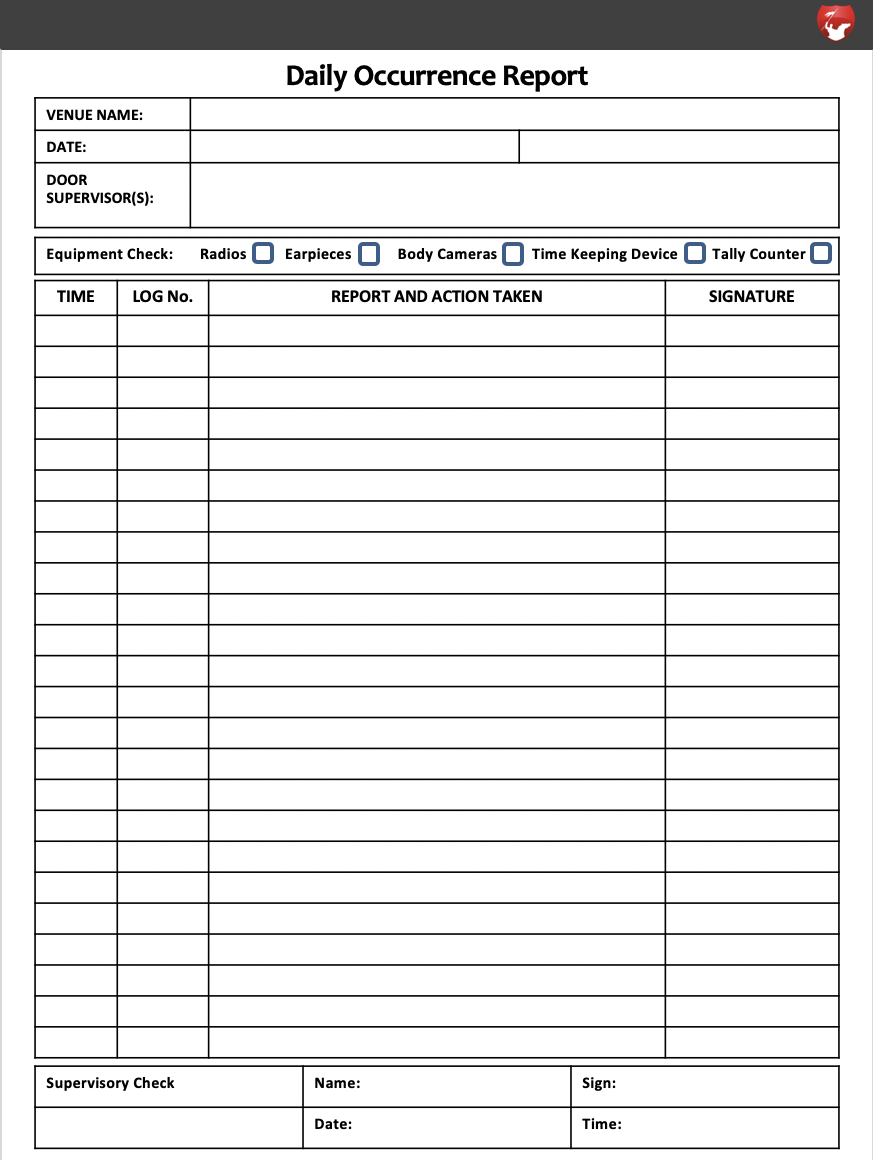
Incident Report Guide: All You Need To Know
Published on: 26 May 2023 By: SafetyCulture
You can complete an online incident report below.
Incident Report
Fire Safety – What Security Professionals Need To Know
Published By: Get Licensed
Awareness & Responsibility
Fire is a devastating occurrence for life and property. Two of the things that security personnel are charged with protecting. Awareness of fire risk and the actions to take are the responsibility of each security operator. The 6-day training course for your SIA door supervisors licence will involve fire awareness training.
Your responsibility is to maintain that awareness and training. This will enable you to act calmly and efficiently in the event of a fire.
Reasons For Being Trained In Fire Safety
It is not just the flames that are dangerous in a fire.
- Smoke inhalation is the most common cause of death in a fire.
- Becoming overcome by the heat.
- Lack of oxygen as the fire burns up all the oxygen present.
- Risk of physical injury as fire-damaged structure starts to fall.
- Not having an escape route due to it being blocked or not able to open an exit.
Understanding Fire
Fire is where fuel + oxygen + heat combines, creating a fire triangle. Remove one of the elements, and you won’t have a fire. The same goes for a fire tetrahedron, where you have a fourth element of chemical reactions. By removing one of the elements, you will put out the fire. Fire extinguishers play an essential role in removing a component to control fire.
Fire Prevention
It is imperative you learn the simple measures you can take in preventing fires on your watch. Things like
- Making sure fire exits are clear and can easily be accessed.
- Keeping the workplace tidy – or taking note when it isn’t and inform the relevant manager.
- Effective management of waste – know what is flammable
- Knowing how to reduce the risk of electrical fires occurring.
- Know where the fire exits are and how they open.
- Be aware if staff or customers don’t respect the need to keep them clear of obstruction.
- If any item of equipment is found to be damaged or deficient, it should be reported to Management immediately.
Be alert for telltale signs of a fire:
- Smell
- Noise
- Smoke
- Flames
Learn the location of fire alarms and fire extinguishers. Ensure that exit signs are visible, Be aware of any other fire precautions in a building like water sprinklers and fire hoses.
Fire Extinguishers & Their Uses
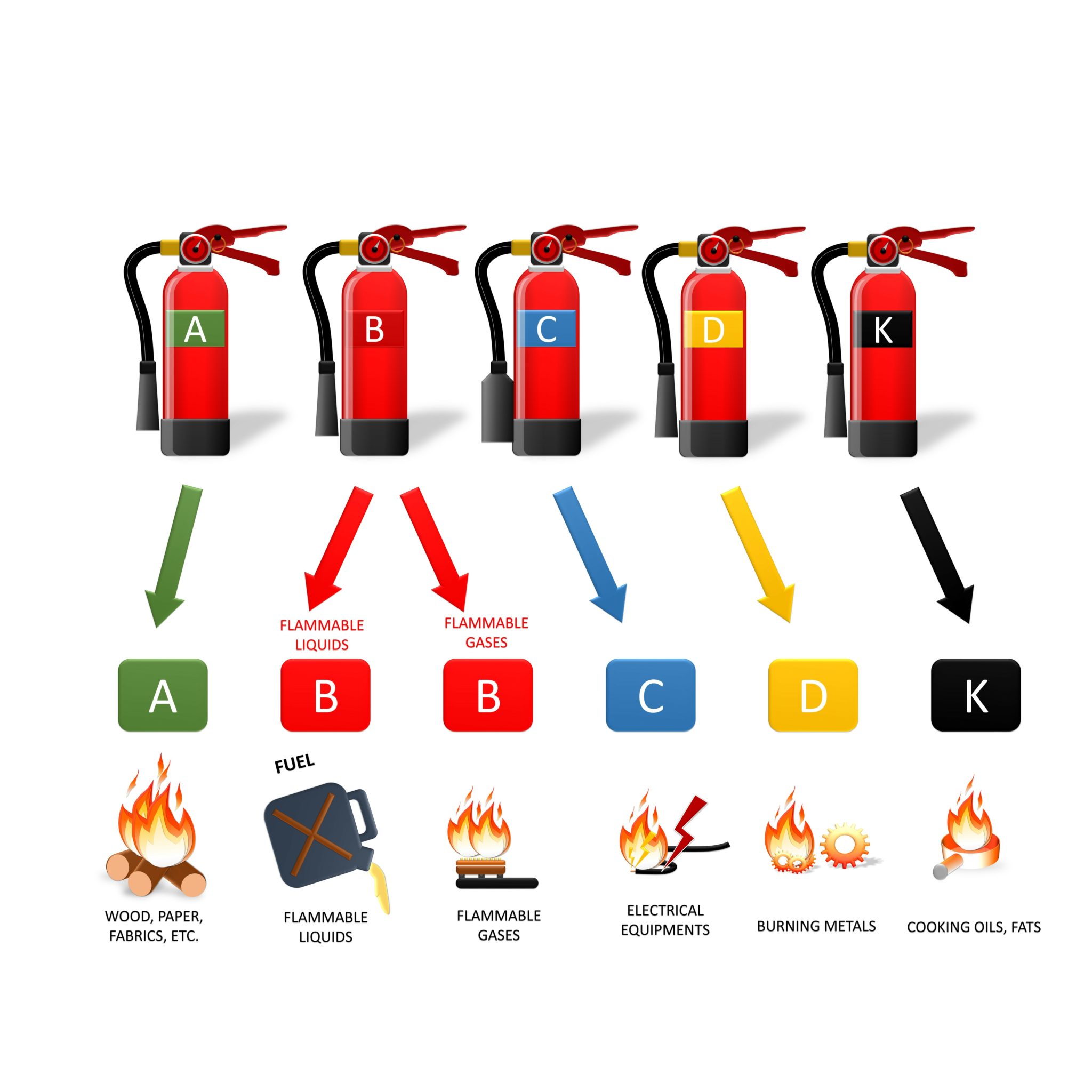
Six Categories Of Fire
Class A fires – fueled by combustible materials—including wood, paper, and textiles
Class B fires – fueled by flammable liquids—such as paint, petrol or spirits
Class C fires – fueled by combustible gases—including propane and butane
Class D fires – fueled by volatile metals—chemicals such as potassium, magnesium or lithium
Electrical fires – fueled by electrical equipment—computers and photocopiers etc. Removing the electrical component changes the fire’s class.
Class F fires – fueled by cooking oils—chip-pan fire or olive oil or butter.
It is crucial to have the correct extinguisher for the area. Fire extinguishers are designed to tackle particular fuels.
Fire Extinguishers – Water
One of the most common fire extinguishers, these release water under high pressure. They are for Class A fires.
Do not use a water fire extinguisher for:
- Kitchen fires
- Fires involving electronic equipment
- Fires caused by flammable liquids or gas.
Fire Extinguishers – Foam
These extinguishers are for Class B and Class A fires. The foam creates a barrier between the fuel and the oxygen.
Do not use a foam fire extinguisher for;
- Kitchen fires
- Fires involving electronic equipment
- Fires caused by flammable liquids or gas.
Fire Extinguishers – Dry Powder
These extinguishers are for Class A, B & C fires and fires that involve electrical equipment up to 1,000v. There are also specialist dry powder extinguishers for flammable metal fires, like titanium. It would be best to avoid using dry powder extinguishers in an enclosed space to prevent inhaling the powder.
Do not use a dry powder fire extinguisher for:
- Fires involving electronic equipment over 1000v
- Kitchen fires involving cooking oil
- Fires raging in enclosed spaces.
Fire Extinguishers – Carbon Dioxide ( CO2)
These extinguishers are the primary option for electrical fires and Class B fires. They are found mainly in business with a high electrical equipment component like server rooms and tech stores—these work by suffocating the fire, removing the oxygen element, which lets the fire die out.
Do not use a CO2 fire extinguisher for:
- Fires involving flammable metals
- Kitchen fires
- Fires involving materials like paper or textiles.
Fire Extinguishers – Wet Chemical
These extinguishers are for Class F fires, with cooking oil, so found in places with kitchens, restaurants, hotels, cafes, chippies, etc. These are also usable for Class A fires—but a foam or water extinguisher would be a better option. They work by starving the fuel of oxygen by creating a foam layer on top of the burning oil. The fine mist it produces when activated is potassium. Potassium reacts to the oil, making a foamy or soapy film. This also acts as a coolant.
Do not use a CO2 fire extinguisher for:
- Fires involving flammable liquids or gasses
- Electrical fires
- Fires involving flammable metals
A risk assessment will decide which extinguishers are necessary for a building and where. As a licensed security officer, it is your responsibility to familiarise yourself with where they are —the same goes for fire hoses—and how to operate them.
Like with all aspects of security work, you need to stay sharp and stay calm. Implement the emergency procedures for the building you are in. If there are no such procedures, then be proactive and ask what your role would be in the event of a fire.
Calling 999 | Fire
Published By: London Fire Brigade
Medical Emergencies
As part of the SIA Licence training, it is now a requirement for a door supervisor to complete a first aid qualification before taking their licence-linked training. So use your training, skills and own judgement when dealing with medical emergencies. However, we've included some links to resources that may help you refresh your knowledge.
HSE | Basic Advise on first aid at work
NHS | When to call 999
British Red Cross | First Aid
St Johns Ambulance | First Aid Advice

Protect UK | Bomb threat Guidance
Published By: Protect UK
![]()
National threat level
The threat to the UK (England, Wales, Scotland and Northern Ireland) from terrorism is:
SUBSTANTIAL

The current UK threat level for terrorism can be located on the gov.uk website’ www.gov.uk/terrorism-national-emergency
Bomb Threat Checklist
We have provided our Bomb Threat Checklist/Guidance Form below for your use, however, there are other checklist online that can be used.
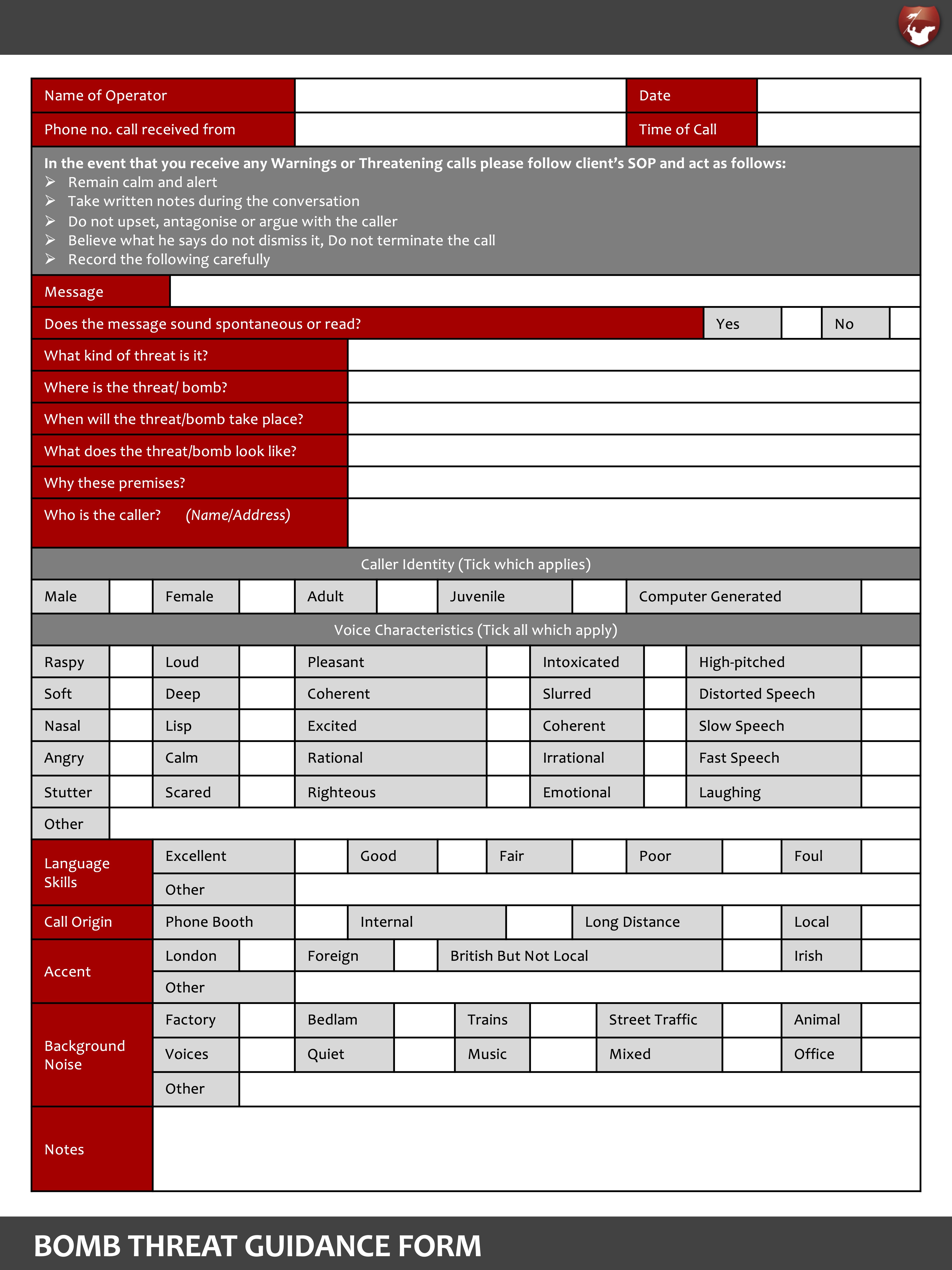
How to Protect Yourself and Others: Guidance for Security Operatives
A job in Security can be difficult; dealing with members of the public in challenging circumstances and often placing yourselves in harm’s way. The SIA (Security Industry Authority) have provided some guidance on good practice to help you continue to protect the public and keep yourself safe.
Helping Vulnerable People
When working in the night-time economy you have an important role to identify and support people who may be vulnerable.
Look out for signs of vulnerable individuals, who might be:
- under the influence of alcohol or drugs
- alone or receiving unwanted attention
- separated from friends
- lost or isolated
- being followed or threatened
- victims of child exploitation
- under the age of 18
- elderly
- with mental ill-health
- with learning, physical, or a range of invisible disabilities

If you are concerned about someone’s ability to get home safely, please consider the following:
- seek the help of street pastors, street marshals or any other active schemes
- call a relative to help in the case of a younger or vulnerable adult
- get a taxi or private hire vehicle for the person concerned (private hire vehicles must be booked through a licensed operator by phone, app or at a booking office; taxis can be hired the same way or hailed in the street or at a taxi rank)
- use ‘safe havens’ or other local initiatives run by organisations such as St John’s Ambulance
- call the police
Physical Intervention to Avoid
You should only use physical intervention as a last resort and never use more force than is necessary.

- Avoid high risk methods of restraint, such as neck holds and other holds that can damage the spine and adversely affect breathing or circulation
- Positional asphyxia typically occurs during forceful restraint involving weight or pressure on the torso
- Avoid high risk positions including ground restraints
Use of Force
I agree that any force I use will only be used as a last resort and only when alternatives have failed. I agree that I will use good communication and conflict management skills to resolve potential violent situationsI understand that I must account for any use of force, and that any force I do use must be reasonable, necessary and proportionate in the circumstances. I confirm that I understand how and when to record incidents and near misses and informed of the location of the incident report book to record incidents I have witnessed or been involved in. I am aware of locations of the preferred ejection routes and that this is due to CCTV coverage in these areas which will protect my reputation and reassure the ejected customer. I have been informed of which restraint techniques are to be avoided as illustrated above and I agree to avoid their use. I have been informed of the codes used for communication i.e. in the event of a fire, fight, drugs or assistance required. I have been assessed and deemed competent in basic skills for radio communication. I can confirm my awareness of the process of signing in & out, and the re-charging of radios and reporting faulty radios to the HDI can confirm I have read and understand the physical intervention guidance provided in this assignment manual.
I will use my own skill, experience and judgement in providing these services
Positional (or restraint) asphyxia – what is it?
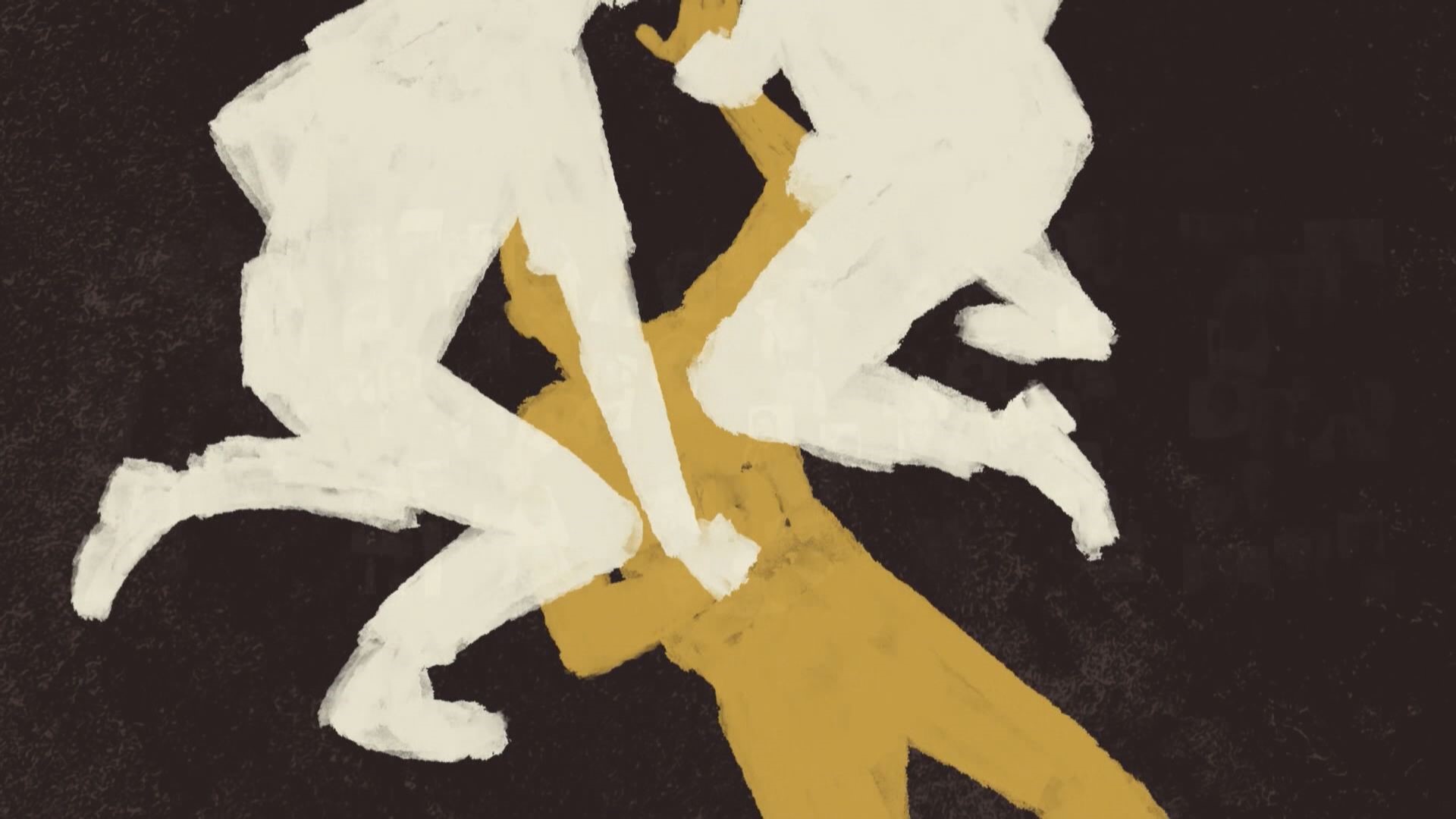
Positional asphyxia occurs mostly during ground restraints, although can also occur in other positions. This is where a person is held forcefully, face down or face up, on the floor. Many people have died as a result of positional asphyxia during forceful restraint. Others have suffered permanent brain damage linked to oxygen deprivation. You should avoid restraints that carry a heightened risk of positional asphyxia.
What can cause positional asphyxia?
Method of restraint: Positional asphyxia typically occurs during forceful restraint involving weight or pressure on the torso. All forceful restraints on the ground carry heightened risk.
Position: Forceful holds in certain positions increase risks of positional asphyxia. These positions include face up or face down restraint, either on the ground or another surface such as a bed or bar/counter. Also seated or standing positions where breathing and/or circulation are compromised e.g. by being bent forward.
Duration: The longer a person is held in a position and/or by a method carrying heightened risk of positional asphyxia, the longer their exposure to risk and subsequently potential for harm and death.
Follow your emergency procedures and training which can include:
- Immediately cease the restraint (if restraint was being applied)
- Check Airway – Breathing – Circulation (A-B-C)
- Place in the recovery position
- Call appropriate emergency services
- Commence CPR/defibrillator if necessary
- Provide emergency services with a briefing that includes anything known about the person affected that may help their assessment and treatment. Include details of any restraint including the method, position and duration.
Act on ‘red flags’ during or following a restraint
- Effort with breathing
- Blocked airway and/or vomiting
- Passivity or reduced consciousness
- Individual being non responsive
- Signs of head or spinal injury
- Facial swelling
- Evidence of alcohol or drug overdose Blueness around lips, face or nails
- Individual held complaining of difficulty breathing
- High body temperature, profuse sweating/hot skin
- Exhaustion
- Confusion, disorientation and incoherence
- Hallucinations, delusions, mania, paranoia
- Bizarre behaviour
- Extreme fear
- High resistance and abnormal strength
Safety Culture Survey
We feel the incidents of abuse security personnel are subjected to occur happen too frequently and all of us are guilty of accepting this as part and parcel of the job.
We have crated a survey to get your opinions on the Safety Culture in Security and want to here your views. You can complete the survey at: Safety Culture Survey
The relevant results of this survey will be shared with IPSA International Professional Security Association to raise awareness within governing bodies.
SIA Training Video
Door supervisors play a vital role in keeping the public safe - especially if you’re working in clubs and bars during busy periods. Please watch this SIA video with reminders of your training in ways to spot and help people in vulnerable situations. Your skills can help protect the public from predatory behaviour, spiking, and sexual assault.
Video Link: www.youtube.com/watch?v=5dEv2Cz7MKk
Overdose Factsheets
The International Overdose Awareness Campaign have provided factsheets, that you can download on the following overdose types:
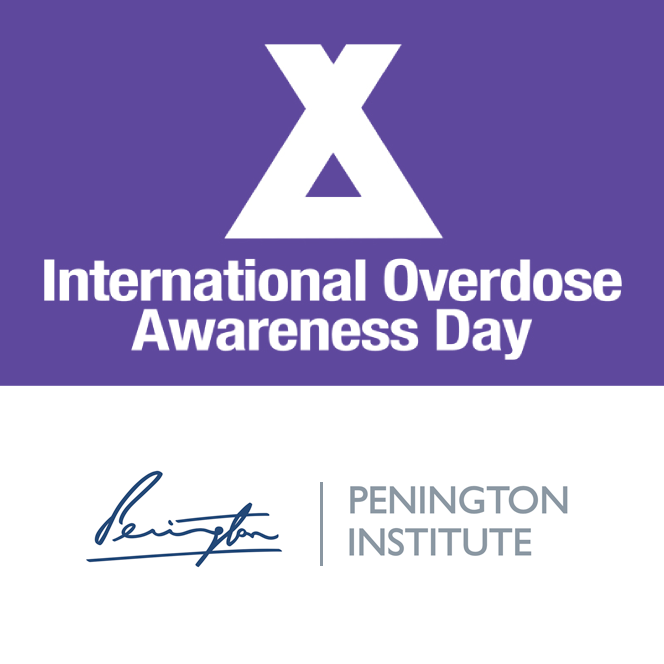
You should only use physical intervention as a last resort
Physical intervention can:
- Increase risks of harm to staff and customers
- Result in prosecution if use of force was unnecessary, excessive, or in any way unlawful
- Lead to allegations against staff and potentially loss of licence and/or work.
Examples of a ‘last resort’ situation include:
- Where necessary to prevent harm
- When other options have failed, or are likely to fail
- When it is not possible or appropriate to withdraw
Alternatives to Physical Intervention
Primary Controls:
- Use your training
- Follow the client’s safety and security policies, procedures and working practices
- Use of safety and security equipment (e.g. radio for summoning assistance, CCTV)
- Being positive and proactive in service delivery
Secondary Controls:
- Positive and effective interpersonal communication and the knowledge and skills of conflict management to de-escalate conflict situations and reduce the need for physical intervention
Your responsibility during physical intervention
- Use the least forceful option
- Maintain duty of care to the subject following restraint
- Respect the dignity of people being restrained wherever possible
- Provide appropriate medical attention to any person who appears to be injured or at risk
- Challenge unnecessary and excessive use of force by colleagues
- All staff involved in a physical intervention have a responsibility to ensure the safety of everyone involved
- Where more than one member of staff is involved in a physical intervention, one of them should take charge of the intervention
Your responsibility immediately after a physical intervention
- De-escalate a restraint at the earliest opportunity
- Maintain duty of care to the subject following use of force/restraint
- Provide appropriate medical attention to any person who appears to be injured or at risk
- Preserve evidence and secure witnesses
- Staff involved must fully report and account individually for their actions
- Tell the emergency services (if present) about the circumstances, position, duration and any difficulties experienced in a restraint event
Reducing the risks of physical intervention
- Choose the least forceful intervention practicable
- Avoid high risk positions including ground restraints
- Avoid high risk methods of restraint, e.g. neck holds
- Keep up communication between staff and the subject during and following restraint
- Monitor the wellbeing of the subject of intervention for adverse reactions
- Ensure that leadership and teamwork happens, e.g. someone taking a lead role while others support
- Ensure practice follows the procedures taught
- De-escalate physical intervention at the earliest opportunity
- Immediately release and assist subject if they complains/demonstrates signs of breathlessness or other adverse reactions
- Record and report restraints in line with a venue's procedures
Other Useful Resources
SIA Licensing Criteria | July 2022
SCaN for all staff- Highfield Learning Module
Staying Safe Online: Top Tips for Staff E learning
GOV.UK CT Awareness- Helpful Advice
ACT Report Suspicious Activity
NPSA- Marauding Terrorist Attacks
St Johns Ambulance- How to do a Primary Survey
Mental Health Awareness at Work E-learning
BIIAB | Level 2 Award in Security Guarding


